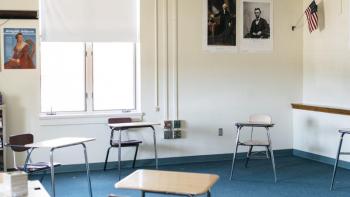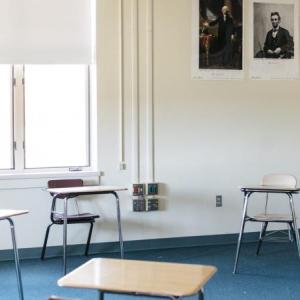What happens to school budgets when Mainers vote ‘no’?
A small group of people gathered in a sweltering cafetorium — a room that serves as both cafeteria and auditorium — at Gray-New Gloucester High School on Wednesday night. They were there to discuss the district’s school budget, which had failed at the polls by 19 votes in June.
Residents sat in hard plastic chairs facing the school board members and a well-scuffed stage. Efforts to build a new performing arts center were rejected in recent years, so the school will need to use capital reserve funding to make updates. The installation of a new air quality system is underway, with the help of state funding.
After taking a vote, board members silently signed and shuffled a stack of papers, approving a new $34.9 million budget — down from $35.2 million proposed in the spring, which was about a six percent increase over last year. The new figure, now 4.8 percent higher than last year, will go before voters first at a townhall-style budget validation meeting on July 24, and again at the polls during back-to-school week in August.
“We really get to this place where there’s nickels in the cushions for this year’s budget,” said board member Sam Pfeifle during the meeting.
Maine School Administrative District 15, which serves the Cumberland County towns of Gray and New Gloucester, is one of at least a dozen districts that saw its school budget shot down earlier this summer, according to a Maine Monitor review of news reports and other public sources.
Those districts, which range from Kennebunk to Madawaska, are now returning to the drawing board, weighing cuts to supplies, extracurriculars, and in some cases, staff.
The state Department of Education and groups such as the Maine School Management Association and Maine Education Policy Research Institute said that they do not collect any formal data on the number of school budget rejections, and MSMA said this year’s count did not seem out of the ordinary.
School administrators gave different reasons for why they thought the budgets failed: confusion over how the budgeting process works, concerns that district spending was “wasteful,” disapproval with district plans to close a school, as well as broader frustration with rising taxes overall.
These local conversations are part of a larger debate about how Maine’s schools are funded. As education costs have risen and enrollment has declined in many districts in recent years, and as the influx of pandemic relief funds has come to an end, there have been increased calls for the state to reevaluate its model for apportioning its share of the funds.
In MSAD 15, the tension has been simmering for a while. Last summer, residents petitioned for a recount of the budget vote, which had narrowly passed by nine votes. The recount reached the same outcome.
This spring, residents also expressed concern on unspent funds that were carried into the new proposed budget, attempted to decrease portions of regular instruction and special education funding, and displayed broad frustration over the budgeting process.
“We really shouldn’t be surprised,” Dr. Chanda Turner, MSAD 15’s superintendent, said of the June budget failure.
She also highlighted growing tensions in the community over how much each town is required to contribute — a split set by charter when the two towns formed the district decades ago. Gray, which is the larger of the two towns and has about 1,000 students in the district, pays for about 67 percent of the budget, while New Gloucester, which has about 760 students, pays for 33 percent. Residents in Gray decisively nixed the budget, while New Gloucester supported the measure.
As schools wade through these tense budget conversations, district leaders are also contending with federal funding uncertainties, adding new questions to what are already complex negotiations.
“There’s a lot of factors at play here,” Turner said, “all of which are incredibly complicated and interwoven.”
‘A cry for help’
Superintendent and regional school executive director Ben Sirois oversees three districts in northern Maine: MSAD 27, Madawaska and MSAD 33. Of those, only MSAD 33 passed its school budget this year.
Two of the five towns in MSAD 27, Fort Kent and Wallagrass, voiced their frustration by issuing resolutions opposing the budget, which would’ve seen their local taxes increase by 8.2 and 9.4 percent — an amount officials said would be difficult for residents to swallow, according to The County.
Sirois said the community has always supported public education, and believes they still do, but worries that people are taking out their frustration with rising costs of living on one of the few things they have a direct say over.
“To be fair, increased taxes are never popular,” Sirois said. “You have these communities here in Northern Maine — they’re an aging community, so a lot of people on fixed budgets, and not able to absorb those increased costs, especially when everything else is going up. I think, in the past, folks were okay with a slight tax increase because everything else was stable. But now with everything so unstable, it’s a cry for help.”
In Fort Kent and Wallagrass, around a third of residents are 65 or older, according to the latest census data.
In Androscoggin County, Lisbon shot down its proposed school budget in an overwhelming 724-312 vote. A second question on the ballot asked whether the proposed budget was “too high, too low, or an appropriate amount” — voters overwhelmingly indicated that it was too high.
“Why in the hell should I be paying school tax when I don’t have students in school?” one local resident told The Sun Journal. “They need to do something about this. People are losing their homes.”
Officials said they believed residents were also responding to the town budget’s 11 percent increase, which does not go to a public vote and is rising in part to fix a municipal accounting error. The town’s share of the proposed school budget was a 5.7 percent increase over the previous year.
“I want to apologize to you all, that you and your school budget have been the victim of what has been a very clear outcry from the public regarding the municipal side of the house,” said town council member Norm Albert, according to reporting by The Sun Journal.
In MSAD 58, which serves the western Maine towns of Strong, Phillips, Avon and Kingfield, a number of issues were at play prior to the school budget rejection: two towns have initiated the process to withdraw from the district, and the other two towns are considering taking the same step, in part out of fear that the district will close one of the local schools.
Superintendent Laura Columbia said the school district’s perspective boils down to making sure resources aren’t spent on aging buildings, but instead on the kids in the rural district.
“I grew up in poverty — education got me out of that. That’s what I want for the kids: I want a sustainable model in this area for our kids,” Columbia said, growing emotional as she spoke. “Just by where we are geographically, they do not have access to the resources that other kids in our state do. So our schools are the place where we can make those connections, see what the world is like, see that the world is bigger than just their town.”
What’s being cut?
Many school districts get some amount of funding from the state: in the 2024-25 school year, Maine covered 55 percent of the total, statewide cost of a basic education. The state’s formula, known as Essential Programs and Services, determines the local and state split based on factors like town valuations and student enrollment. Most towns raise funds that go well beyond this figure to fund programming like advanced classes and athletics.
Running a school district is not a simple operation: they must hire and maintain a workforce, operate buildings, purchase supplies, provide transportation and more. In MSAD 15, the revised budget includes cuts to athletic spending, debt service, paid family medical leave and health insurance.
“We are not at a place, at this moment, that we are looking to fire people, for lack of a better phrase,” Turner said. The school district had already eliminated several open positions, including for a part-time music teacher, a full-time American Sign Language teacher, a part-time secretary and five education technicians.
In Aroostook County, MSAD 27 is laying off two people and eliminating empty roles in addition to making cuts to supplies and travel. An administrative assistant shared with a neighboring district and a floating substitute — which had been funded with pandemic relief money — lost their jobs.
In Southern Maine, RSU 21 cut a communications specialist, in addition to delaying or seeking alternative funding for repairs at an elementary school, reducing board expenses and more.
“If a budget validation referendum fails — what are the options? In order to move the needle there, you really have to look at personnel. That’s really the only place where you can really make some significant changes to your costs,” said Eric Waddell, the executive director of the Maine School Management Association. “Nickel-and-diming supplies and interscholastic athletics and activities — those are very, very inexpensive compared to the overall budget and won’t really move the needle.”
Navigating funding challenges
“What we’re doing now in Maine schools — I’m not sure how sustainable that’s going to be over the next decade,” Waddell said.
He pointed to a growing need for resource sharing across districts to reduce costs. He stopped short, however, of suggesting school building consolidation or district reorganization.
Some researchers have pointed to consolidation as one of the most effective ways to reduce costs. Navigating a conversation around consolidation is tricky, however, as many towns see their local schools as part of their identity. Some towns have gone so far as to leave their school districts entirely to maintain local control and preserve their schools, despite the cost.
This year, there’s another wrench in the works: federal funding uncertainties.
As the Trump Administration continues to slash what it believes is wasteful spending, several federal grants that flow to schools through the Maine Department of Education have been paused as part of a larger freeze on $6.8 billion in congressionally-approved funds. These include grants that support migrant education, English language learning, academic enrichment, and resources for rural and low-income areas. Maine joined two dozen states in suing the administration over the decision to withhold this money earlier in July.
While some superintendents maintain hope that all federal funding will come through this year, many warn that if it doesn’t, the impact could further constrain budgets. While federal funding typically makes up a small portion of school budgets — around 15 percent — a loss in funding could fall on taxpayer shoulders.
Districts set aside contingency funding, which, if unspent, is typically used to offset taxpayer impact in the next fiscal year, Turner said. But it’s not enough to cover lost federal funds.
If a school district suddenly had expenses that went well beyond the budget, she said, the result could be “catastrophic” and could require drastic measures such as hiring freezes or eliminating roles mid-year.
“I can’t even wrap my head around what that would look like,” Turner said.
This story was originally published by The Maine Monitor, a nonprofit civic news organization. To get regular coverage from The Monitor, sign up for a free Monitor newsletter here.


























